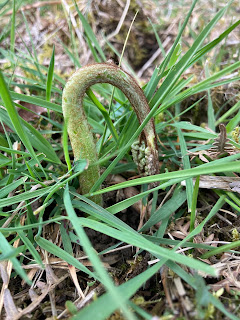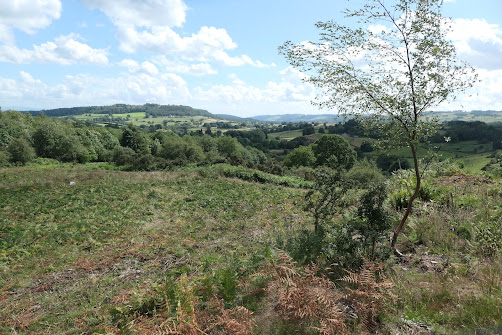Preparing to plant gets physical
Having delayed planting from January to November 2023 to address the bracken problem, the work to try and reduce its vigour has been taking place over the summer.


The first signs appeared in May when the bluebells were in flower. It grew quickly through the month but the hot June with no rain did appear to slow the vigour of the growth somewhat.
It reached full height by late June
The mower has a wide turning circle which leaves margins where I want to plant with untouched growth.
Growth on the right is about 1.8m high.
The second cut was planned for late August. The bracken has returned less vigorously this year. I’d like to think that this is because it has been weakened over the last 2 years but I suspect it is the weather we have had this year. No rain for the whole of June meant that it grew less vigorously and then being cut didn’t get going again as it was cold and wet. It is only about knee high and quite sparse at the point that the second cut was due.
I have therefore decided to use the contractor time to tackle the untouched growth and to bash the second growth myself. I can manage 3 hours knocking back the new growth while tackling the large stuff I can only do about half an hour at a time and need breaks.
I am working my way around the planting zones and have done 3 out of 6 of them including those worst effected. With a few more days up there it will be done. I am hoping a contractor can tackle the larger stuff if not I may get stuck into that again myself before the bracken dies back naturally. The idea is to stop the current growth from replenishing the rhizome so that the plant goes into winter depleted. Once the saplings have been planted in November there will be no room for mowing and so future management will be using a petrol strimmer or by hand. I shall spend the winter investigating kit that I may need to buy,
The second piece of preparation I have been working on is getting the second hand tree guards ready for the contractors. A neighbour bought a wood that had been planted 17 years ago. Unfortunately due to the personal circumstances of the previous owners, the guards were not removed from the trees. The new owners have taken about 2,000 off the trunks from trees that have grown or found ones on the ground where the tree did not thrive. These are plastic and cannot be recycled as they have deteriorated being outside for so long. Since they were on trees in my valley I have said I will take them to reuse with my planting as I am not concerned about any cross contamination. While I would prefer non plastic biodegradable ones and will buy these for the rest of the trees I am planting (over 4,000 in total) re-using these is the greenest choice (achieves all three of the 'reduce, re-use, recycle' goals in one step). Where the guards are damaged and cannot be used these will go into household waste which in Cumbria is used for energy generation.
I have collected 2 car loads of guards so far which I think is about 700. I noticed that some are full of moss and sticks and the odd frog! They will be difficult for the contractors planting the trees to use in their current state. I have embarked on a project to prepare them by cleaning them in the beck and putting them into bundles of 25 so they can be carried around the site to the different planting zones as needed. So far I have completed 525. I have tried different cords for tying them up and have got this down to 7p a guard. Cheaper materials don’t hold them as well and will be difficult to manage in cold weather or would be plastic based which I do not want to use - the best so far is jute. This compares to the price of 26p per a new spiral tree guard (maybe cheaper for bulk) but this does show that it is worth this extra work to reduce the number of guards being purchased by about half financially as well as environmentally.
I have put some of the guards to good use already. I have planted some saplings which have been donated and also found some regenerative growth now that the deer have been excluded and I have been protecting these from small mammals.




































It’s amazing what you are doing Annabel ,xxxx
ReplyDeleteThank you!
ReplyDelete